2010 VOLKSWAGEN GOLF ABS
[x] Cancel search: ABSPage 17 of 516
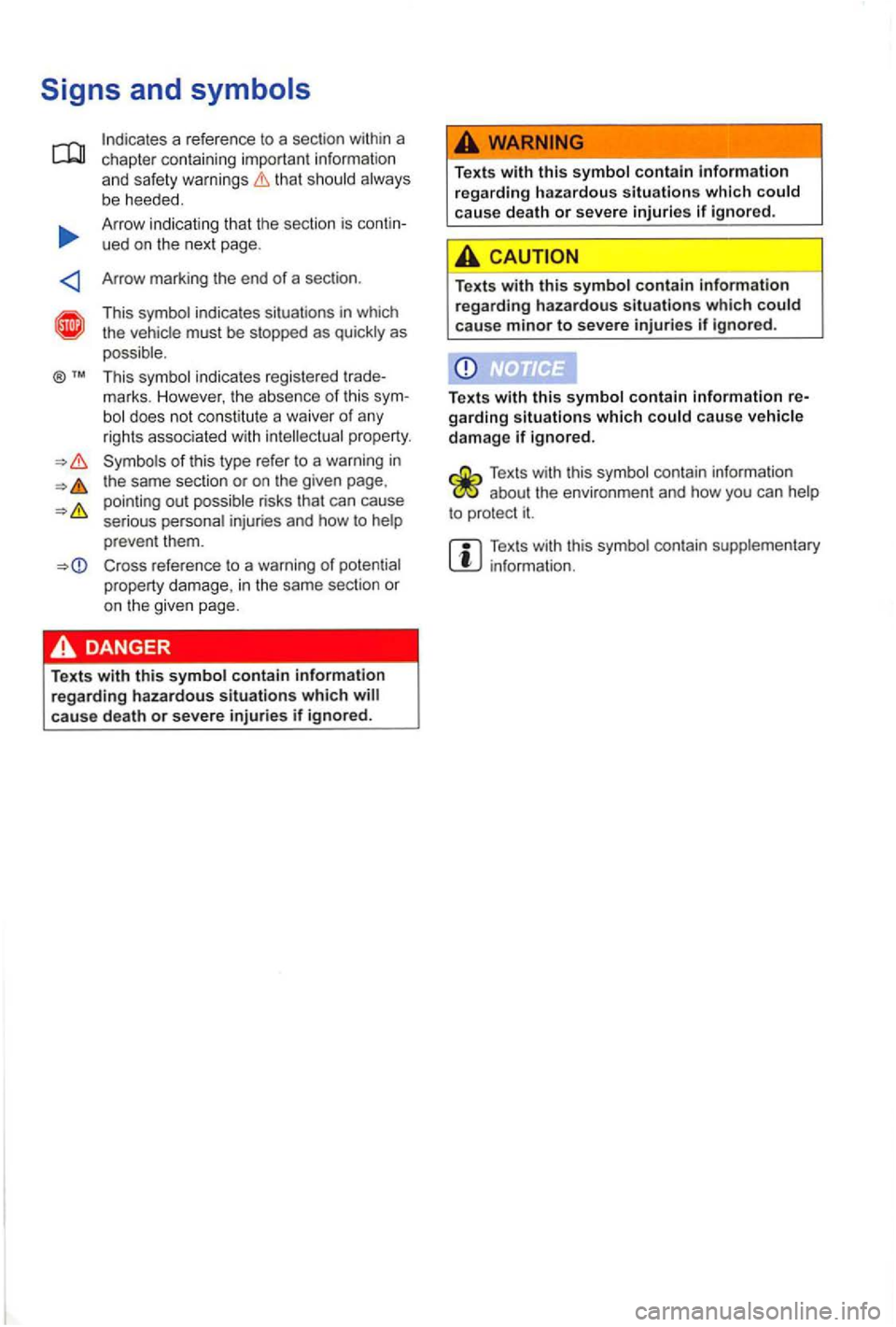
that should always
b e heeded.
A rrow indicating that the section is contin
ued on the next page .
Arrow marki
ng the end of a sec tio n .
This symb ol ind icates situa tions in which
t he vehicle must be stopped as quic kly as
possible.
Thi s sym bol indica tes regist ered trade
mark
s. H owever, the absence of this sym-does not const itut e a wa iver of any
rights associated with intellectual property.
Cross referen ce to a warning of poten tial
property damage, in the same sec tion or
on the given page.
T ex ts
with this symbol contain information regarding hazardous situations which cause death or severe injuries if ignored.
Texts with this symbol contain information
regarding hazardous situations which could
cau se death or severe injuries if ignored.
Texts with this symbol contain information regarding hazardous situations which could cause minor to severe injuries if ignored .
Texts with this symbol contain information re
garding situation s which could cause vehicle damage if ignored.
Texts with this symbol contain informa tion about the envi ronmen t and how you can
Texts wit h this symb ol co ntain supplementary info rmati on.
Page 100 of 516

a reference to a section with im
p orta nt informat ion
and safety warnings that sh ould always be heeded.
Arrow indicating that the sect
ion conti nues
on the next page .
Arrow marking the end
of a section.
The symbol indicates situat ions in which
the vehicle must be stopped as quickly as
possible.
Th e symbol indicates registered trade
marks. Howe ver, the absence of this sym-
bol does not constitute a waiver of any
rights associated with intellec tua l property .
Cross-reference
to a red , o range, or yel
low warning in the same section or on the
s tated page, pointing out possible risks
that can cause serious personal injuries
and how to help prevent them.
Cross reference to a Notice about possi
ble property damage, in the same section
o r on the stated page.
Texts
with this symbol contain information regarding hazardous situations which cause death or severe if not avo ided.
Texts with this symbol contain information regarding hazardous situations which could
cause death or severe injuries if not avoide d.
Texts with this symbol contain information regarding hazardous situations which could cause minor or moderate injuries if not avoid-ed .
Texts with this symbol contain information re
garding situations which could cause vehicle damage if not avoided .
Texts with this symbol contain information about the envi ronment and how you can help to protect it.
Texts with this symbol contain supplementary information .
Page 170 of 516
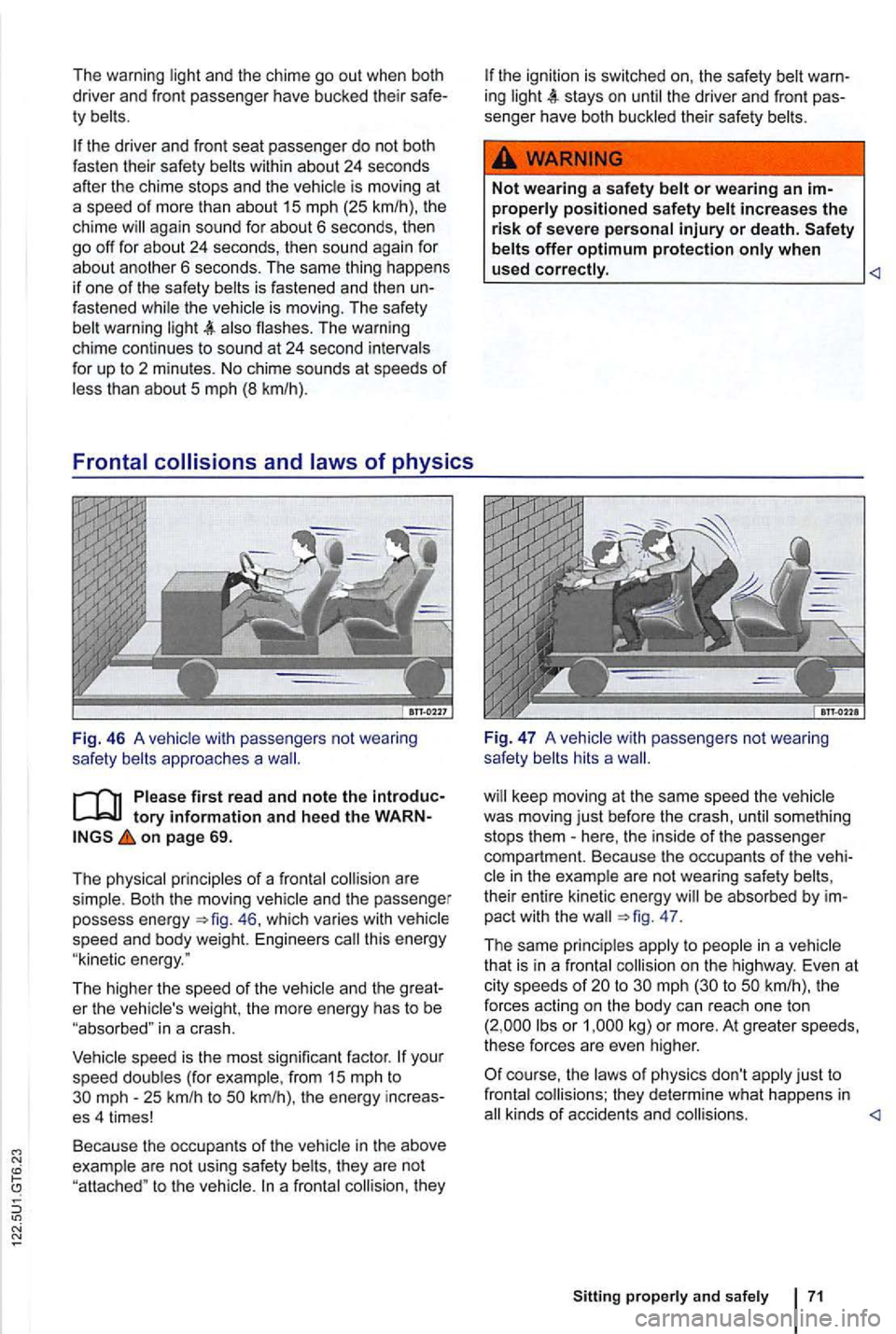
and the chime go out when both
driver and f ront passenger have bucked their ty
again sound for about 6 seconds, then go off for abo ut 24 seconds, then sound aga in for about anolher 6 seconds. The same thing happens
i f one of the safety fastened warning
of physics
Fig. 46 A vehicle with passengers not wearing safety
on page 69.
The physical principles of a frontal are
s imple . Both the moving vehicle and the passenger
possess energy 46, which varies with
er the vehicle 's weight, th e more energy h as to be "abso rbed" in a c rash.
speed is the most significan t factor .
they are not "attached " to the
increases the risk of severe personal injury or death.
with passengers not wea ring
safety
keep moving at the same speed the ve hicle was moving just befo re the cras h,
in the example are not wearing safety their entire kinetic energy pact with the 47.
The same principles on the highway. Even at
c ity speeds of 20 to 30 mph (30 to 50 km/h), the
fo rces acting on the body can reach one ton
(2 ,000 o r kg) or more. At greater speeds,
these forces are even higher.
of physics don't j ust to frontal they determine what happens in kinds of accidents and
Page 172 of 516
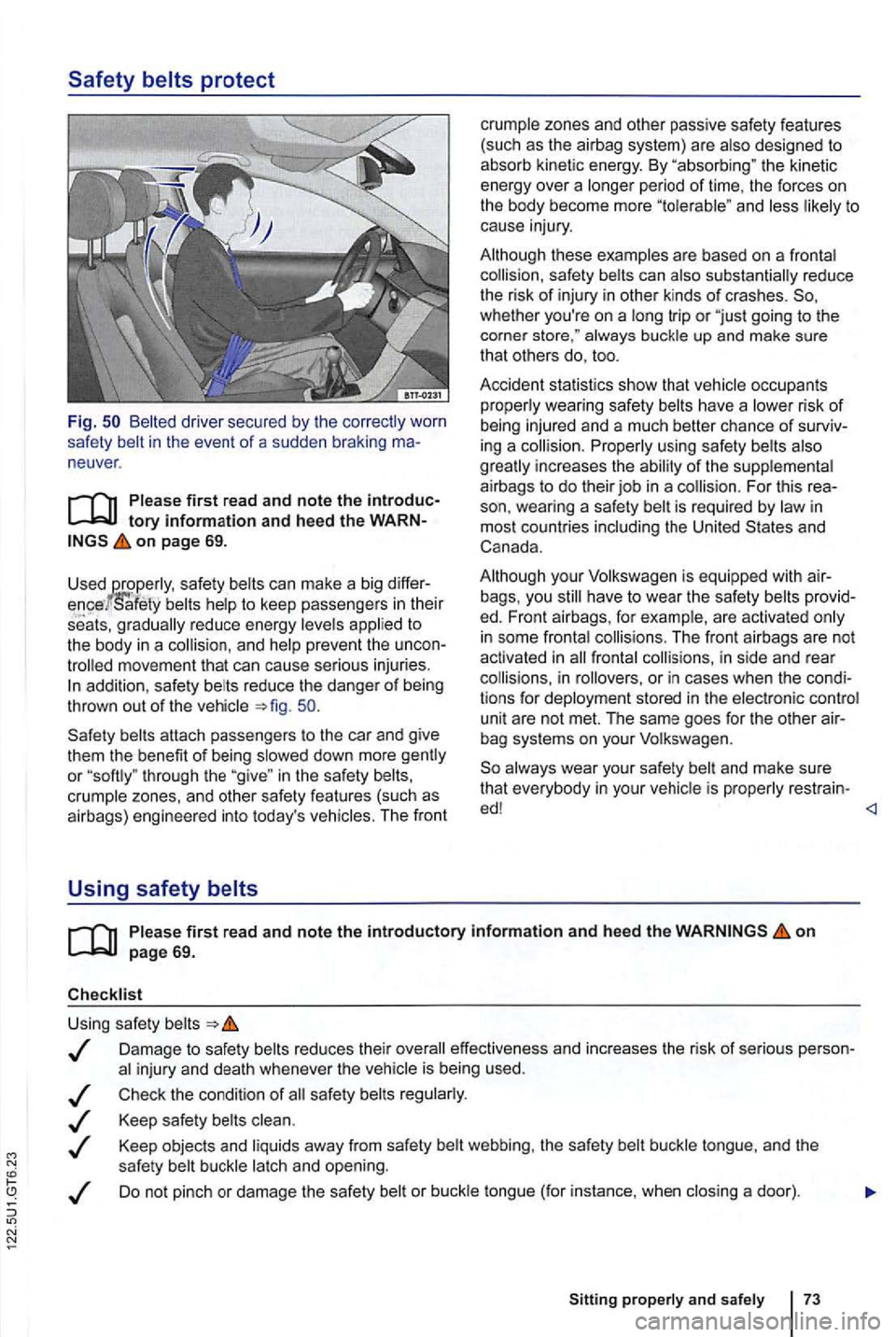
Safety belts protect
Fig. Belted driver secured by the
neuver .
on page 69.
Used safe ty can make a big
to
the body in a co llision , and help prevent the
addition , safe ty reduce the danger of being
thrown out of the vehicle
or through the in the safety crumple zones, and other safety features (such as
airbags) engineered into today's The front
Using safety belts
crumple zones and other passive safety features
(such as the airbag system) are also designed to
absorb kinetic energy. By "absorbing " the kinetic
energy over a longe r pe riod
of time, the forces on
the body become more to
cause injury.
Although these examples are based on a fronta l
collision , safety
whether you're on a long trip or "just going to the
corner always buckle up and make sure
that others do, too.
Accident statist ics show that vehicle occupants
p roperly wearing safety
also
g reatly increases the ability of the supp lementa l
airbags to do thei r job in a collision. For this is required by in
most countries including the United
your Volkswagen is equipped with have to wear the safety
bag systems on your Volkswagen.
always wear your safety is properly restra in -
ed!
o n
Damage to safety reduces their overall effectiveness and increases the risk of serious injury and death whenever the
Check the condition of
webbing , the safety buckle tongue, and the
safety buckle latch and opening.
Do not pinch or damage the safety
Page 190 of 516
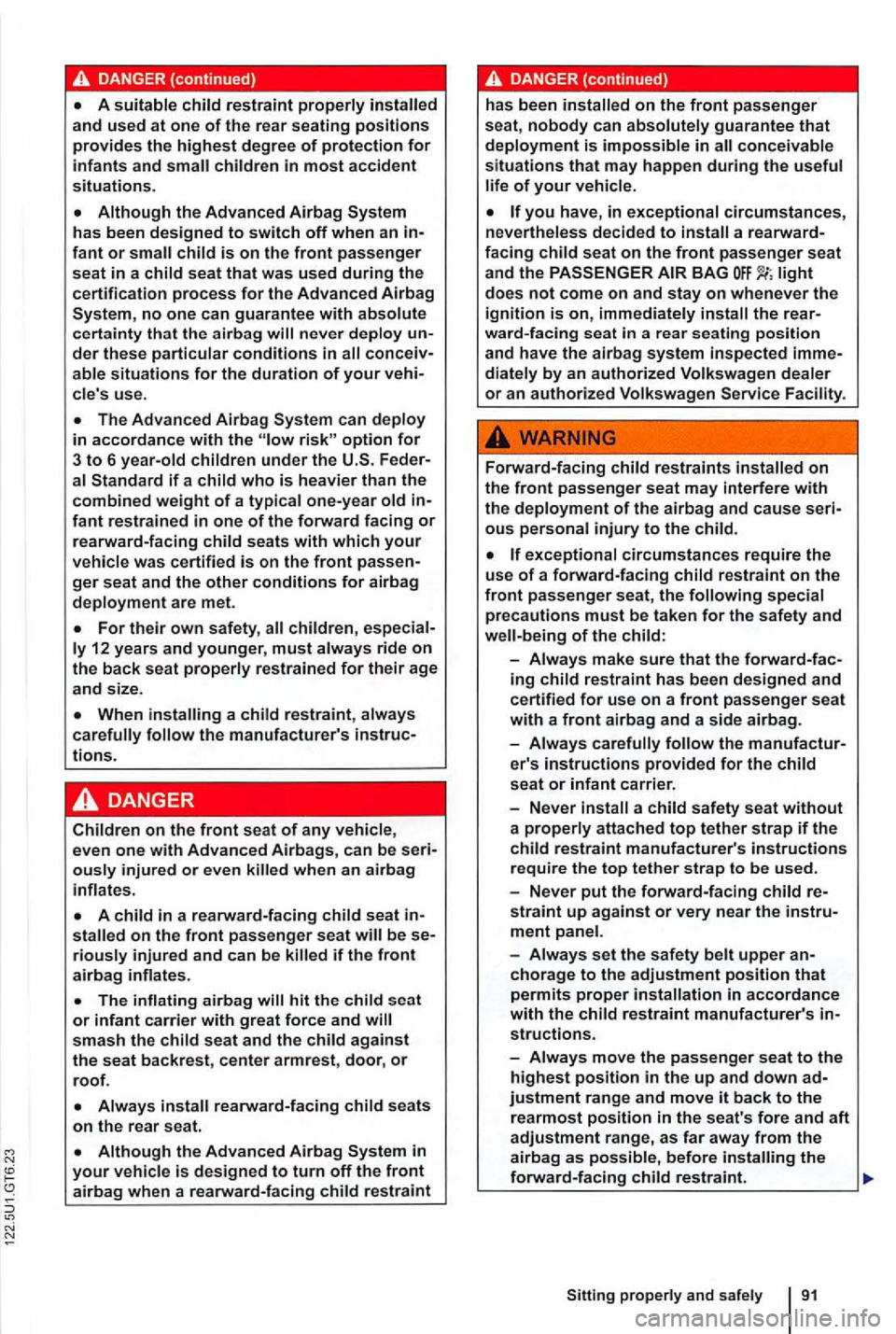
no one can guarantee with absolute certainty that the airbag never deploy
can deploy in accordance with the option for 3 to 6 year-old children under the if a child who is heavier than the combined weight of a typical one-year old fant restrained in one of the forward facing or rearward-facing seats with which your vehicle was certified is on the front passenger seat and the other conditions for airbag deployment are met.
on the front passenger seat if the front airbag inflates.
smash the child seat and the child against the seat backrest, center armrest, door, or roof.
conceivable situations that may happen during the useful life of your vehicle.
light does not come on and stay on whenever the ignition is on, immediately
ous personal injury to the child.
exceptional circumstances require the use of a forward-facing child restraint on the front passenger seat, the following special precautions must be taken for the safety and of the child:
-Always make sure that the forward-facing child restraint has been designed and certified for use on a front passenger seat with a front airbag and a side airbag.
-
Always carefully the manufacturer's instructions provided for the child seat or infant carrier.
- Never
straint up against or very near the instrument panel.
-
Always set the safety belt upper chorage to the adjustment position that permits proper installation in accordance with the child restraint manufacturer's
Sitting properly and safely 91
Page 192 of 516
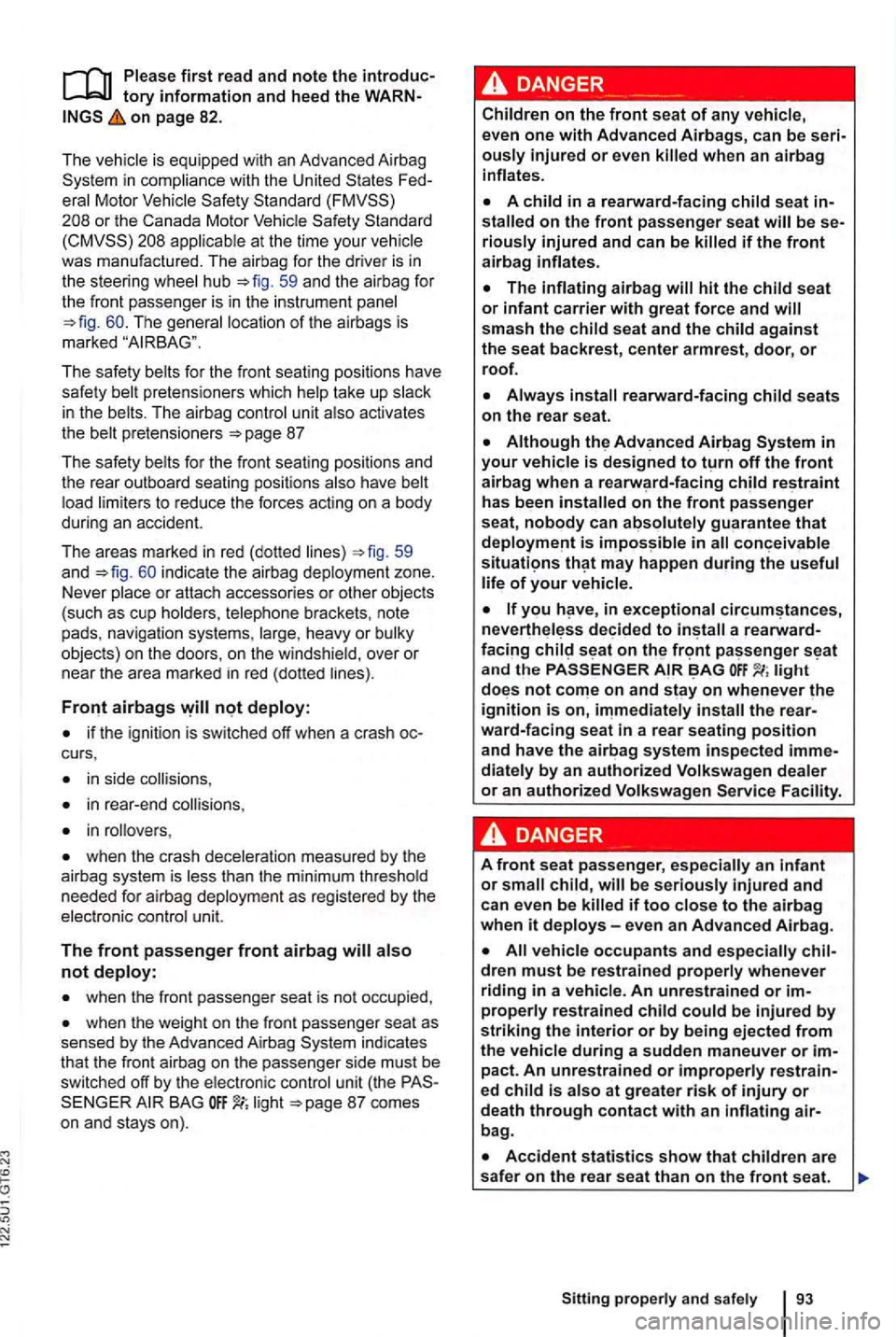
on page 82.
The is equipped with an Advanced Airbag
Standard
appl icable at the time your
The safe ty belts for the front seating positions have
safety belt pretensioners which help take up slack
i n the belts. The airbag contro l u nit also activates
the belt pretensioners
59
and i ndicate the airbag deployment zone.
Never place or attach accessories or other objects (such as cup holders , telephone brackets, note
pads, navigation systems, large , heavy or bu lky
objects) on the doors , on the windshie ld, over or
near the area
marked in red (dotted lines).
if the ignition is switched off when a crash
in side collisions ,
in rear -end
in rollovers ,
when the crash deceleration measured by the
ai rb ag system is less than the minimum threshold
needed for airbag deployment as regis te red by the
elec tronic cont
rol unit.
The front passenger front airbag
when the front passenger seat is not occupied ,
when the weight on the front passenger seat as sensed by the Advanced Airbag indicates
that the front airb ag on the passenger side must be
s witched o ff by the electronic control unit (the BAG li g ht
ously injured or even
stalled on the front passenger seat will be riously injured and can be killed if the front airbag inflates.
has been installed on the front passenger
seat, nobody can absolutely guarant ee that
you in exceptional a
light not on and stay on whenever the ignition is on,
dren must be restrained properly whenever
riding in a vehicle. An unrestrain ed or
bag .
Page 249 of 516
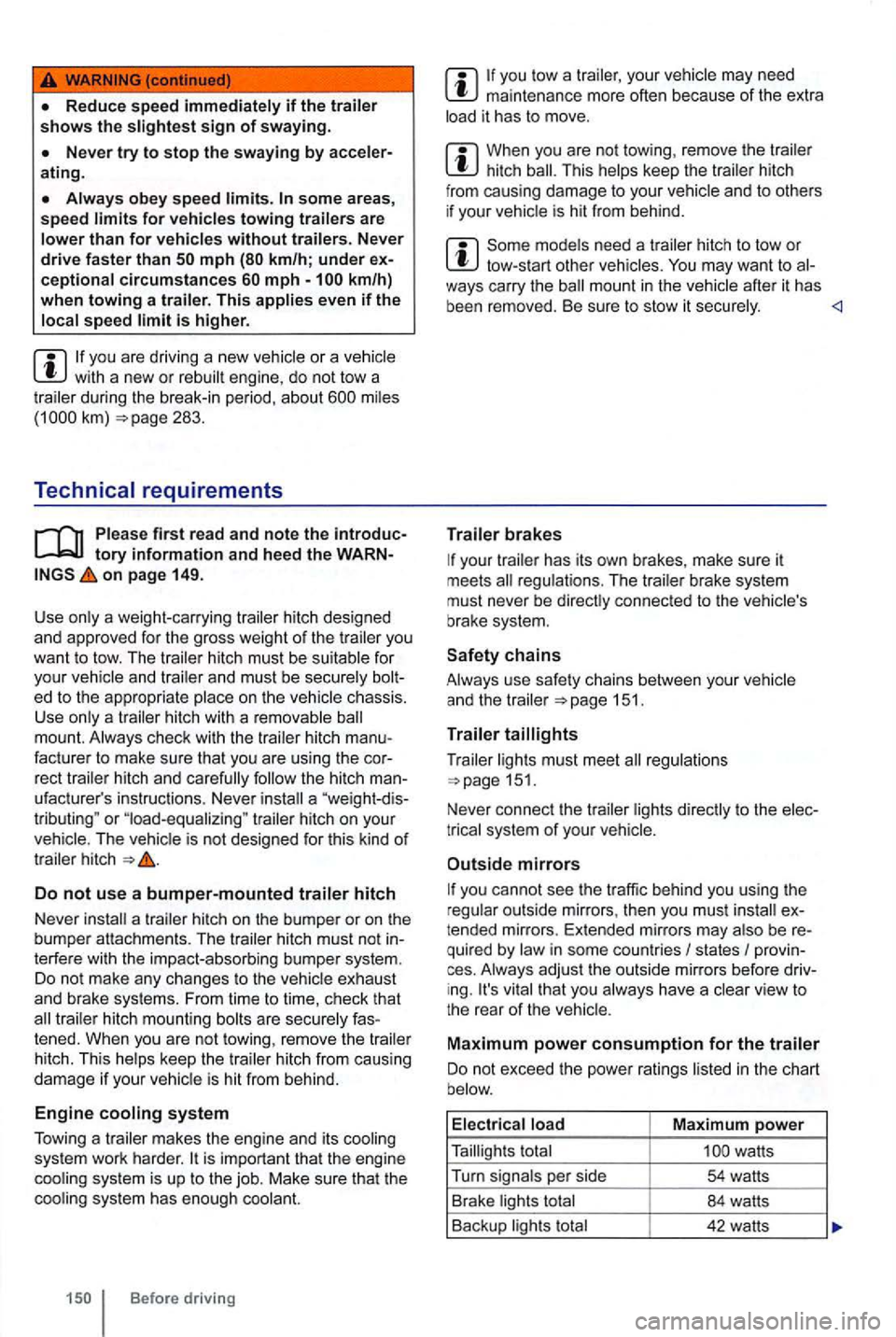
some area s, speed
is higher.
you are driv ing a new vehicle or a ve hicle with a new or rebui lt engine, do not tow a during the break-in period, about 283.
Technical requirements
tory informatio n an d heed the WARNon page 149.
Use only a weight-car rying
hitch must be suitable for
you r
a "weight -dis
tributing " or "load-equalizing " trailer hitch on your The vehicle is not designed for this kind of trailer hitch
Do not use a bumper-mounted traile r hitch
Never
a trailer hitch on the bumper or on the
bumper attachments. The trailer hitch must not in
terfe re with the impact-absorbing bumper system.
Do not make any changes to the vehicle exhaust
and brake systems. From time to time, check that trailer hitch mounting bolts are secure ly fas
tened. When you are not towing, remove the trailer
hitch. This
helps keep the trailer hitch from causing damage if your vehicle is hit from behind.
Engine cooling syste m
Tow i
ng a trailer makes the engine and its cooling
system work harder.
Before driving
maintenance more often because of the extra
load it has to move.
When you are not towing , remove the trailer hitch
Some models need a trailer hitch to tow or tow-start other vehicles. after it has
been removed. Be sure to stow it securely.
your trailer has its own brakes , make sure it
meets
151 .
T ra
iler
Trailer lights must meet regulations 151.
Never connect the trailer lights directly to the elec
t rical system
of your
Outside mirrors
you cannot see the traffic behind you using the
r egular outside mirrors, then you must ex
t ended mirrors. Extended mirrors may also be re
quired by law in some countries
I states I provin
ces . Always adjust the outside mirrors befo re dr iving. It's vital that you always have a clear view to
the rear of the veh icle .
Maximum po w er con sumption fo r the trailer
Do not exceed the power ratings listed in the chart
b elow.
E l
ectr ica l load Maximum power
Taillights total
Page 278 of 516
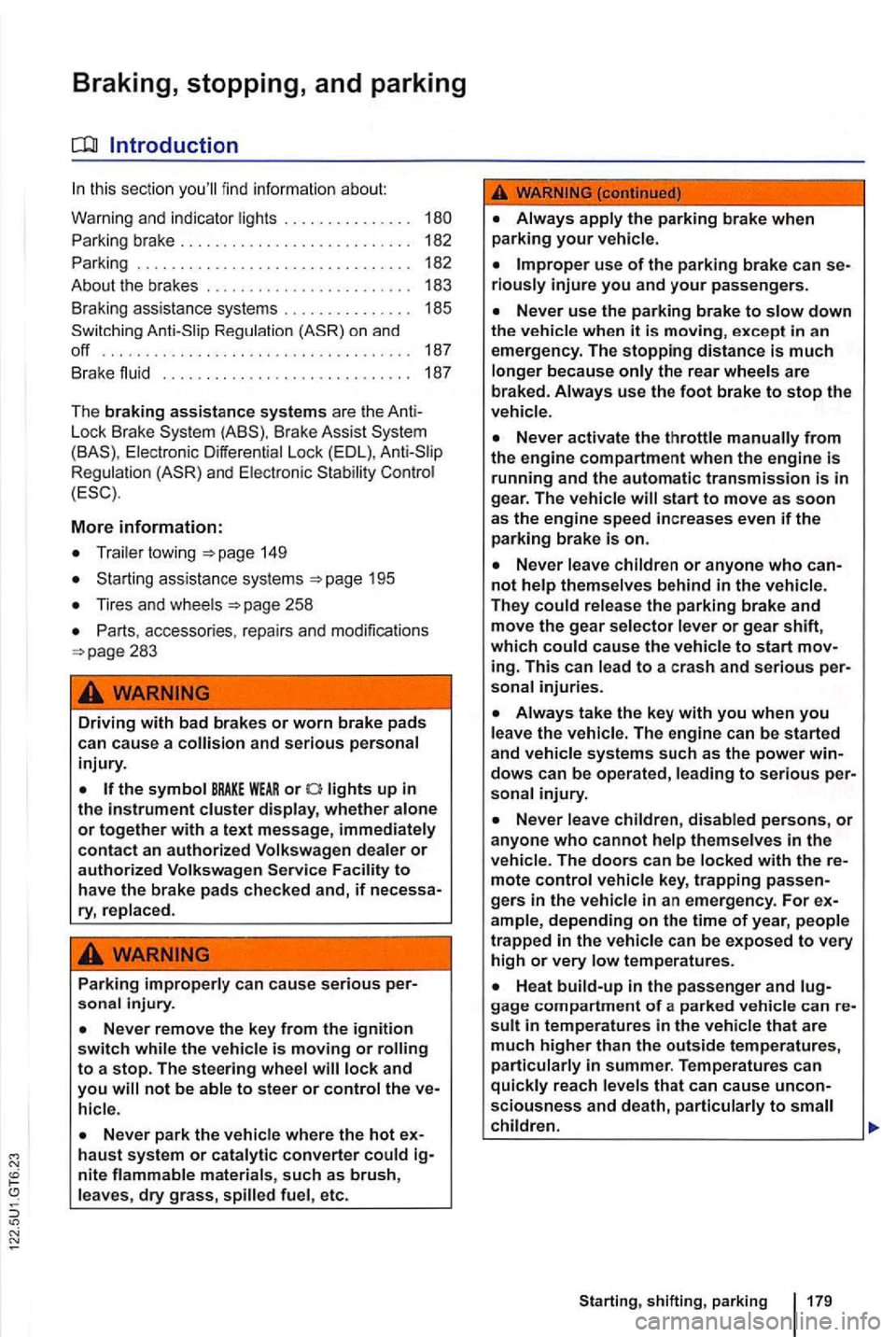
Braking, stopping, and parking
this sectio n
Parking brake . . . . . . . . . . . 182
P arking . . . . . . . . . . . . . .
. . . . . . . . . . . . . . . . . 182
About the brakes . . . . . . . . . . . . . . . . . . . . . . . . 183
Braking assistance systems
Switching
L ock Brake System (ABS) . Br ak e Assist System
(BAS ), Ele ctronic Differential Lock (EDL), R eg ulatio n (ASR) and Electronic C ontrol
(ESC).
More information:
Trai ler towi ng 149
Starting assistance systems 1 95
Tires and whee ls 258
Driving with bad brakes or worn brake pads can cause a and serious personal
injury.
lights up in the instrument cluster display, whether alone or together with a text message, immediately contact an authorized Volkswagen dealer or authorized Facility to have the brake pads checked and, if necessa
ry, replaced .
Parking improperly can cause serious sonal injury.
lock and you
haust system or catalytic converter could
fu el, etc.
riously injure you and your passengers.
sonal injury.
mote control vehicle key, trapping passengers in the vehicle in an emergency. For ample, depending on the time of year, people trapp ed in the vehicle can be exposed to very high or very low temperatures.
children.
Starting, shifting, parking 179